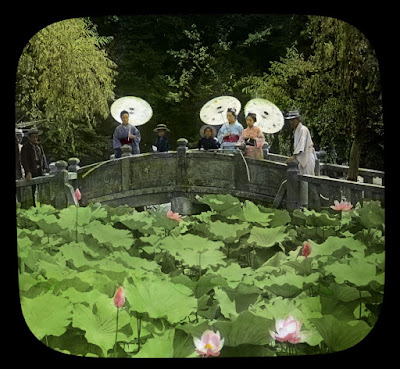Dr. Edward Sylvester Morse: Marine Biologist, Collector, and Scholar
Dr.
Edward Sylvester Morse
Marine
Biologist, Collector, and Scholar
 |
Yoshu Chikanobu (1838 - 1912,
Japanese), Tokyo Aristocratic School
Picture of Banquet of Gakushu,
1877, Woodblock print, 36 x 72 cm, ChY.04.09 a-c |
Many may not know, but
here at the Whyte Museum, we have a rich and diverse collection of Japanese
objects and art. In January 2018, Dr. Gain Chin, an Associate Professor
Emeritus at the University of Regina, provided a scholarly assessment of our
Japanese collection. She was able to add depth and clarity about the cultural
significance and value of our collection. How you may ask, did we acquire such
objects? Come with us on a journey of the man known as Dr. Edward Sylvester
Morse.
Morse specialized in the study of malacology, which focuses on mollusca. Mollusca includes snails, slugs, clams, octopus, squid, and so on. As a marine biologist he focused heavily on this classification of invertebrates. In 1870, he published a book that reclassified braciopods as worms, rather than mollusks. In 1877, Morse went in search of coastal braciopods in Japan. This short stay turned into a three year adventure for Morse. During this time he fell in love with the culture and people of Japan. He would return to Japan in 1882 and begin to amass a large collection of objects.
 |
Lotus
Flowers in Shiba Park, [ca. 1908 - 192-],
Mary Schäffer fonds (V527/PS/1/874)
|
So, what is the
connection to the Whyte Museum? Morse was Catharine Robb Whyte's maternal
grandfather. Through her personal letters and diary entries, we can see her
immense fondness for him.
 |
[Catharine
Robb (Whyte) with Edward Morse], n.d.,
Peter and Catharine Whyte fonds
(V683/IV/A/PA-181)
|
Catharine described the
collecting tendencies of her grandfather in a diary entry,
"Grandpa never
threw anything away, even letters from Mother which just say, "Will meet
you Saturday," . . . I cleaned out the attic. We found old hats, shoes,
boots, masks, pictures, coffee pots, maps, an old warming pan, fishing rods,
boxes, shells, stones, tiles, trunks, bags, screens . . . pottery, old
bottles, kettles, an old sea chest . . . a skeleton of a monkey,
the [hyoid] bone of a 'Peruvian mummy' and a 'section of the human soul'
in one drawer in the desk."
Catharine
Robb Whyte, March 31, 1926
 |
[Dr. Morse's House],
Baldwin Coolidge Phot., Peter and Catharine Whyte
fonds
(V683/IV/A/PA-172)
|
From April to October 2018, we showcased our collection in an
exhibition, From
Morse to Whyte: A Dynastic Bequest of Japanese Treasures. Below is a
selection of Japanese objects and art that were collected by Morse.
 |
Maker Unknown, Doll,
1870 - 1890, Wood,
fibre, plaster, 25 x
10cm, 108.05.0060
|
 |
Maker Unknown, Miniature Basketry Shop, 1870 - 1890, Wood, ceramic, fibre, 25 x 21 x 34 cm, 105.02.0115
|
 |
Kobayashi Kiyochika
(1847 - 1915, Japanese), Snow Scene in Oume, Hunabiki-Doli, Woodblock print,
25 x 37 cm, KiY.04.02
|
 |
Kobayashi Kiyochika
(1847 - 1915, Japanese),
Night Rain at Yanagihara, 1882, Woodblock
print, 25 x 37 cm,
KiY.04.03
|
 |
Yoshu Chikanobu (1838 -
1912, Japanese), Boating Under Cherry Blossoms, 1896, Woodblock print,
37 x 73 cm, ChY.04.12 a-c
|
 |
| Odo Kokusei, Snow in the Dawn, Tale of Prince Genji, 1878, Woodblock print, KkO.04.01 a-c |
 |
Utagawa Yoshitora
(1850 - 1880, Japanese), Twelve Symphonies, 1853, Woodblock print,
37 x 74 cm, MoS.04.01 a-c
|
 |
| Tsukioka Kōgyo (1867 - 1900, Japanese), Untitled [Six Fireflies], 1910, Woodblock, KoR.04.03 |
 |
Maker Unknown, Miniature China Shop, 1870 - 1890, Wood, ceramic, fibre, 25 x 21 x 34 cm, 105.02.0118
|
 |
Ohara Koson (1877 -
1945, Japanese),
Sparrow on Plum Branch, 1910, Woodblock print,
24 x 25 cm, OhK.04.02
|



Comments
Post a Comment